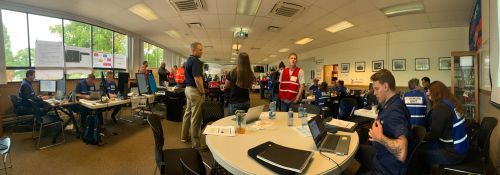NOAA, Partners Exercise a Worst-Case Discharge in Anacortes, Washington
DEC. 12, 2022 — In early October, NOAA OR&R scientists participated in a functional tabletop exercise in Anacortes, Washington. The purpose of the exercise was to demonstrate the capability of the oil industry and other agencies working together to develop an oil spill response plan that is used to minimize and mitigate the impacts of an oil spill.
Participants from numerous organizations worked together during the exercise, including representatives from the U.S. Coast Guard, NOAA, Washington State agencies, County Emergency Management agencies, tribal communities, and oil spill response organizations.
The exercise simulated a worst-case discharge of Alaskan North Slope crude oil into Padilla Bay in northwest Washington. The day began with an ICS-201 Incident Briefing and then followed the organization of the Incident Command System to work through exercise objectives. The various agency participants filled their respective roles in the Unified Command and the situation, operations, and environmental units.
The NOAA scientific support coordinator is a technical expert who provides scientific information to help the federal on-scene coordinator make decisions—during both exercises and responses—that will answer the following questions during an incident: (1) What happened? (2) Where is it going? (3) What resources will it impact? (4) What are the best response methods? (5) What can be done to mitigate the impacts? To answer these questions, OR&R’s Emergency Response Division has a multidisciplinary scientific team of experts in oceanography, biology, chemistry, and more that provide scientific products to support decision making during oil spill exercises and responses.
Prior to the exercise, the planning committee requested that NOAA provide scientific products to support the drill scenario. Among the products provided were: results from OR&R’s ADIOS oil weathering program, to estimate the amount of oil that would evaporate, disperse, or float based on localized conditions; simulated overflights of where oil may be observed over time in relation to local geographic features; trajectories to determine where the oil may go; weather forecasts based on historical average local conditions; and tides and current predictions for the area of the simulated incident. During an exercise, these scientific products give responders practice at evaluating information to make decisions, and also prepare responders for real-world incidents to ensure effective response that minimizes impacts of an oil spill.
Members of the NOAA multidisciplinary team that provided scientific support for this exercise included: from OR&R, CDR Faith Knighton, Pacific Northwest SSC, and LTJG Kyle Vincent, regional response officer; from National Weather Service, Matt Solum, regional response and preparedness specialist, and Carly Kovacik, senior meteorologist. LTJG Eben Smith, fleet environmental support manager with the NOAA Office of Marine and Aviation Operations, also participated to gain experience in large-scale drills using an Incident Command System.
Participation in drills such as this builds partnerships and capacity for planning and preparedness, allowing for more effective oil spill response strategies.
 An official website of the United States government.
An official website of the United States government.


